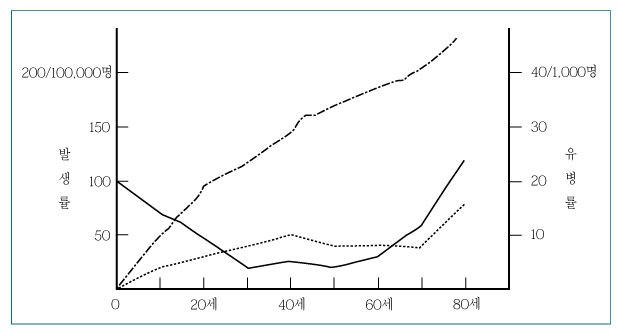J Korean Med Assoc.
2003 Apr;46(4):269-278. 10.5124/jkma.2003.46.4.269.
Epilepsy : Epidemiology and Classification
- Affiliations
-
- 1Department of Neurology, Severance Hospital, Yonsei University College of Medicine, Korea. bilee@yumc.yonsei.ac.kr
- KMID: 2065108
- DOI: http://doi.org/10.5124/jkma.2003.46.4.269
Abstract
- Epilepsy is defined as the condition having the propensity of recurrent seizures and its clinical diagnosis is based on the two or more spontaneous seizures occurring more than 24 hrs apart or one episode of spontaneous seizure associated with an well defined brain pathology. There are two classification systems; one for the epileptic seizures and the other for the epilepsies and epileptic syndromes. The former is simple and clinically useful for the choice of antiepileptic drugs, however, it does not provide any further information regarding the etiology, prognosis, or other clinical characteristics of given patients. For that reason, the latter classification system is being more widely applied at the epilepsy community. However, the syndromic classification of epilepsies, which is based on the clustering of symptoms and signs occurring together, is still at its evolving stage and it should be regarded as the classification system developing into the etiological or pathogenesis-based classification. The incidence of epilepsy is quite variable in different regions, but usually around 40 to 70 cases per 100,000 annually in developed nations with bimodal peaks at the young children and the elderly over age 65. The recent trend of incidence was remarkable for a gradual reduction in young children, contrasted by a rapid rise in elderly population, which might be related to the rapid increase in the proportion of elderly in modern societies. The age-adjusted prevalence of epilepsies is around 0.5 to 1.0% with similar distribution patterns to the incidence. It has been estimated that about 4% of population is expected to develop epilepsy throughout the life time until the age of 80. The natural course of epilepsy is characterized by a spontaneous cure or prolonged remission in about 70% of patients over a prolonged follow-up period (50% without antiepileptic drug treatment and 20% with treatment). These findings clearly indicate that epilepsy is a treatable condition.
Keyword
MeSH Terms
Figure
Cited by 1 articles
-
Surgical Treatment of Epilepsy
Chun Kee Chung
J Korean Med Assoc. 2008;51(3):262-272. doi: 10.5124/jkma.2008.51.3.262.
Reference
-
1. Berg AT, Shinnar S. The risk of seizure recurrence following a first unprovoked seizure: A quantitative review. Neurology. 1991. 41:965–972.
Article2. Hauser AW, Rich SS, Lee JR, Annegers JF, Anderson VE. Risk of recurrent seizures after two unprovoked seizures. N Engl J Med. 1998. 338:429–434.
Article3. Commission on Classification and Terminology of the International League Against Epilepsy. Proposal for revised clinical and electroencephalographic classification of epileptic seizure. Epilepsia. 1981. 22:489–501.4. Luders H, Acharya J, Baumgartner C, Benbadis S, Bleasel A, Wyllie E, et al. Semiological seizure classification. Epilepsia. 1998. 39:1006–1013.
Article5. Commission on Classification and Terminology of the International League Against Epilepsy. Proposal for classification of epilepsies and epileptic syndromes. Epilepsia. 1989. 30:389–399.6. Engel J Jr, Willamson PD, Wieser HG. Engel J, Pedley TA, editors. Mesial temporal lobe epilepsy. Epilepsy: A Comprehensive Textbook. 1997. Philadephia: Lippincott-Raven Publishers;2417–2426.7. Lee BI, Heo K, Kim JS, Kim OJ, Park SA, Kim DK, et al. Syndromic diagnosis at the epilepsy clinic: Role of MRI in lobar epilepsies. Epilepsia. 2002. 43:496–504.
Article8. Everitt AD, Sander JW. Classification of the epilepsies: time for a change? A critical review of the International Classification of the Epilepsies and Epileptic Syndromes(ICEES) and its usefulness in clinical practice and epidemiological studies of epilepsy. Eur Neurol. 1999. 42:1–10.9. Sander JW, Shorvon SD. Epidemiology of the epilepsies. J Neurol Neurosurg Psychiatry. 1996. 61:433–443.
Article10. Hauser WA, Annegers JF, Kurland LT. Incidence of epilepsy and unprovoked seizures in Rochester, Minnesota: 1935-1984. Epilepsia. 1993. 34:453–468.
Article11. Hauser WA, Annegers SF, Kurland LT. Prevalence of epilepsy in Rochester, Minnesota: 1940-1980. Epilepsia. 1991. 32:429–445.
Article12. Annegers JF, Hauser WA, Elveback LR. Remission of seizures and relapse in patients with epilepsy. Epilepsia. 1979. 20:729–737.
Article13. Cockerell OC, Eckle I, Goodridge DM, Sander JW, Shorvon SD. Epilepsy in a population of 6,000 re-examined: secular trends in first attendance rates, prevalence, and prognosis. J Neurol Neurosurg Psychiatr. 1995. 58:570–576.
Article14. Klenerman P, Sander JW, Shorvon SD. Mortality in patients with epilepsy: a study of patients in long-term residertial care. J Neurol Neurosurg Psychiatry. 1993. 56:149–152.
Article15. Annegers JF. Engel J, Pedley TA, editors. Mortality. Epilepsy: A Comprehensive Textbook. 1997. Philadelphia: Lippincott-Raven;99–104.16. Ottman R. Engel J, Pedley TA, editors. Family studies. Epilepsy: A Comprehensive Textbook. 1997. Philadelphia: Lippincott-Raven Publishers;177–183.
- Full Text Links
- Actions
-
Cited
- CITED
-
- Close
- Share
- Similar articles
-
- Changing Perspectives of Epilepsy Classification with Advances in vrain Imaging Techniques
- The Latest Classification of Epilepsy and Clinical Significance of Electroencephalography
- Reappraisal of ILAE Classification of Epilepsies and Epileptic Syndromes : Current Classification and Criticism
- Classification of Epileptic Seizures
- Semiological Seizure Classification


